Interview
04

Interview01.
Artificial Blood achieved through 20 years of passionate research
Interview02.
Getting to the bottom of human's greatest infection periodontal disease
Interview03.
True sustainable society proposed by a biomass researcher
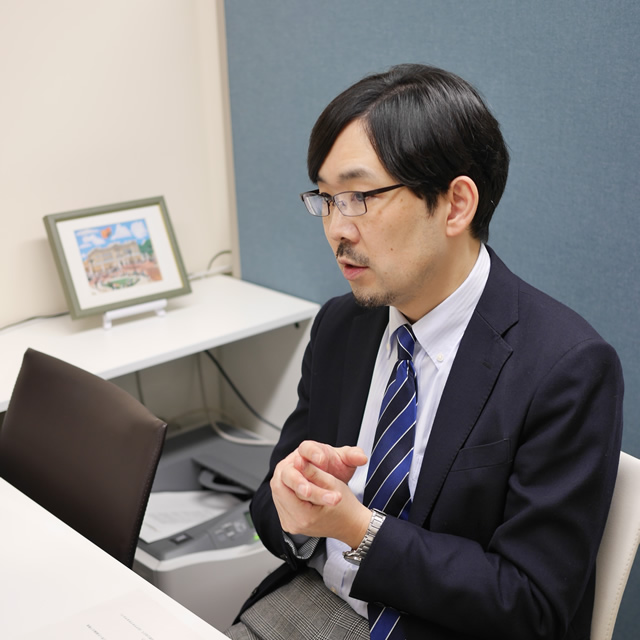
Teruyuki Komatsu
Professor, Department of Applied Chemistry, Chuo University
1966: Born in Tokyo.
1994: Received Ph.D. from the Graduate School of Science & Engineering, Waseda University, Japan.
1993: Research Fellow of the Japan Society for the Promotion of Science (JSPS) at Waseda University.
1995: Postdoctoral Fellow of the JSPS for Research Abroad at Institut fur Organische Chemie, Freie Universitat Berlin, Germany.
1997: Lecturer; Advanced Research Institute for Sci. & Eng., Waseda University.
2003: Associate Professor; Advanced Research Institute for Sci. & Eng., Waseda University.
2006: Researcher, PRESTO, Japan Science and Technology Agency (JST).
2010: Professor; Dept. of Applied Chemistry, Faculty of Sci. & Eng., Chuo University.
This marks the first interview in this series and we are delighted to have Prof. Teruyuki Komatsu from Chuo University, a leading scientist in artificial blood research, discuss his interests back in his student days, as well as his passion for space and current research activities.
A short column explaining the basic information on artificial blood is available for better understanding of the interview.
School days
Thank you for joining us today.
Professor Komatsu, we understand that you study artificial blood. Tell us what initially interested you in studying science?
I don't remember anything specific. Ever since childhood, I have liked science in general and had loads of questions about "why do I get sleepy," "what is life," and "how was the first map was made," among many more. I really liked grapes and thought if I could grow grapes the size of a melon, they would have become very popular. I still bring up the idea from time to time, but no one cares (smiling). So I naturally chose a science course in high school.
When I was a high school kid, astronomers were my heroes. I asked my father for a telescope. I believed that watching stars was the first step to becoming an astronomer. I used it to observe craters on the Moon and constellations in the night sky. Although very interested in space, I had no idea about what job to take in order to become involved in the business of stars and space. I tried to find such a job, but it was beyond my ability, as we had no internet in those days. I gave up the idea, thinking that it must be too hard to make a living in a space-related field (smiling).
It's nice to hear that you were also interested in space.
Did you like science better than other subjects such as economics and political science?
Well, I liked history, too. While at university, I used to teach the history of chemistry. When it comes to history, I studied in Germany for two years after completing my doctoral course. I noticed that many people are deeply interested in their country's history. So they naturally asked me about Japanese history. If I failed to answer a question, I couldn't keep the conversation going. I thus reviewed Japanese history by reading a textbook that I obtained from Japan.
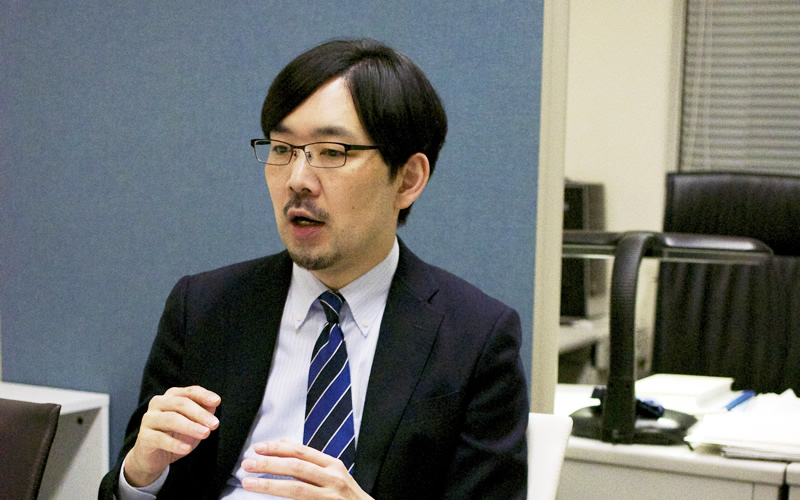
Well, you were a tennis boy.
Exactly. Looking back now, I couldn't stop myself once I was hooked on something. If I may say so, I was once a quarterfinalist at the Inter High School Tennis Championship Qualifier in Tokyo and competed against the main competition there.
Wow! Tokyo is really a competitive area with a huge playing population.
You are good at both studies and sports.
I got stuck on something easily and just kept doing it. When I was making a plastic model plane or a battleship, I didn't even notice my mother calling me for dinner. I often made her wait so long that it made her angry (smiling).
Research Life
At Waseda University, I joined the late professor Eishun Tsuchida's lab for my final year project. He was a pioneer in artificial blood research in Japan and a world-leading scientist in the area. He is also one of the founders of the Society of Blood Substitutes, Japan. That was the first time that I studied artificial blood.
You took a graduate course. Why did you go to graduate school rather than getting a job?
I wanted to be a researcher, but wasn't sure that I would remain in academia. I took a graduate course just because I enjoy research. The fact that my first research paper was published in my second year of graduate school had a huge impact on me. In 100 years, a scientist somewhere in the world may search for articles and learn about my research. Therefore, my name remains in history. It was the moment that I realized the sense of wonder and delight that research could afford me.
You just worked hard and found yourself as a university professor.
Well, becoming a scientist was probably a natural move in my life instead of pursuing my childhood dream.
Tell us about your life after receiving your Ph.D. degree.
Following my doctoral course at Tsuchida's lab, I spent two years in Germany involved in a different project, and then resumed my study of artificial blood at Waseda University after returning to Japan.
When I moved to Chuo University in 2010, I honestly wasn't sure whether I should continue the research. I learned the hard way that developing clinically approved artificial blood is an extremely challenging goal. Promising candidates in the lab all failed when tested on animals due to an adverse or insufficient effect. The situation was the same around the world. Artificial blood had yet to be commercialized. As a new principal investigator setting up my own lab, I tried to devise a new research plan, but all I could think of was artificial blood. It's like my second nature. I decided to go back to the basics and start from scratch following my own idea.
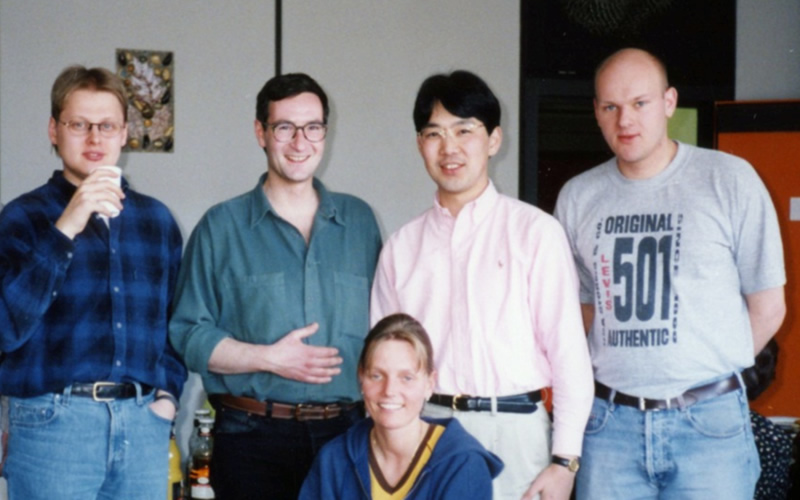
With lab members in Germany, 1997.
So, you've studied on artificial blood during most of your research career. Did you think that such a long-term commitment could lead to the development of a hemoglobin-albumin cluster?
Absolutely. At Waseda University, I tried to create artificial blood by total synthesis, meaning that only synthesized materials were used. It wasn't successful due to certain issues such as stability. Of course, it is extremely difficult to make a substitute for hemoglobin, which evolved through the long history of human evolution.
Albumin, the most abundant protein in blood, caught my eye. As a protein derived from blood, albumin is safe. Moving to Chuo University, I suspended use of the total synthesis method. Instead, I started to use albumin and hemoglobin, the oxygen carrier in our own blood. I was confident that this combination would work well, but confirmation still took two years after I first thought of the idea.
Using hemoglobin and albumin as the two major components of blood absolutely makes sense to me.
Why did no one else think of it for 20 years?
I cannot say. The idea is simple and once it was put forth, people wondered why no one did it before. This sort of thing can often happen in science. Some similar efforts were also made. For example, hemoglobin coated with a water-soluble polymer like polyethylene glycol has been studied for 30 years. However, it has yet to achieve practical use.
I felt very happy that we were the first to show the possible use of hemoglobin-albumin fusion protein as artificial blood. I believe that the results were both unique and useful. We are now collaborating with scientists in medical and pharmacological departments. Our study confirmed that the cluster had no adverse effects on animals.
Utilization of artificial blood
What is a possible scenario for the future use of artificial blood in humans?
In an earthquake disaster, a large quantity of blood is necessary. However, such a large amount of blood cannot be stored all the time. Checking the blood type of patients is also demanding in case of a large number of patients. If a wrong type of blood is transfused, the patient will experience a serious state of shock. Our artificial blood is useful in such a situation. The hemoglobin-albumin cluster can be transfused to a patient having any blood type. It can be stored much longer than the three-week storage period of donated blood in Japan. After that period expires, donated blood must be incinerated. That is why we constantly need blood donations. Conversely, the cluster can be stored for more than a year.
Japan's aging population and low birth rate pose other issues. According to the Japanese Red Cross Society, this trend will lead to a blood shortage for 890,000 patients in 12 years. In this respect, the development of artificial blood having a long shelf life is extremely important.
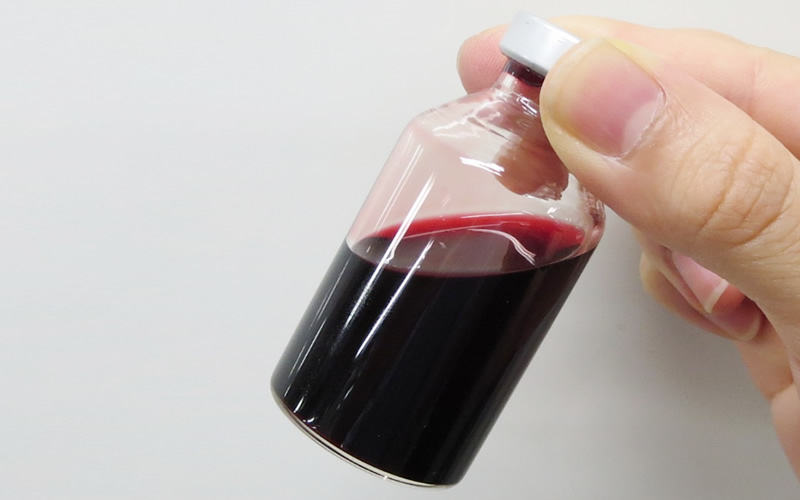
Hemoglobin-albumin cluster prepared as a product
Human beings are not the only ones who need blood substitutes. It is little known that the shortage of blood transfusions for pet animals is quite serious. We don't have to worry about the blood for transfusions in surgery, as blood supply services for humans are well established. Unfortunately, there is no such thing for pet animals like dogs and cats. When a dog is hit by a car and transferred to a clinic, saline (a solution containing the same concentration of salts as in body fluids) is the only blood alternative. Although some large animal clinics keep dogs on hand for that purpose, they are exceptional and the supply is currently unstable.
In Japan, 10.4 million dogs and 10 million cats are kept as pets. The combined number is far greater than the number of young people under the age of 15 in the country (at 16.3 million).
I didn't know that blood will be in short supply for humans in the near future, and that pet animals already face a blood supply crisis.
All the best for your research.
Space experiments
You told us you were fascinated by space when you were a boy. Now you have participated in space experiments conducted in "Kibo" ever since 2013.
What was your reaction when JAXA first approached you? (JAXA did offer the opportunity by reviewing his research activities.)
I was excited, of course. I never thought that I could test my protein under the extreme conditions of space. When members of JAXA got in touch with me, I couldn't believe it and had to refrain myself from asking them, "What are you talking about?"
Well, we surprised you (smiling).
They said they wanted to know about my research, so I invited them to my lab at the university to explain it in detail.

Ryuichi Shinohara (rear), second-year graduate student, explains the component analysis of artificial blood.
Compared with experiments conducted on the earth, space experiments have various limitations, such as limited opportunities and types of experiments. Do you feel any inconvenience?
Experienced protein crystallographers might feel so. I'm not an expert and thus have no such feeling. Instead, I took it as an extraordinary opportunity. They said I didn't have to be a crystallographer and supported me in everything from crystallization to structure determination. If in the same situation, you would certainly want to try.
Researchers
We'd like to ask you more than about the research. What do you think is the most important thing as a scientist?
Once you decide something, you must not give up. Honestly, I almost did, but it was too late to do so (smiling). That approach made me what I am today, and I guess it is the main point.
Excellent, we are so impressed by your enthusiastic and frank discussion with us.
I really enjoy my time being involved in research. If I didn't enjoy it, how could my students enjoy it? I urge them to become a professor as a future career, saying, "how lucky I am to have a career allowing me to have such fun at work" (smiling).
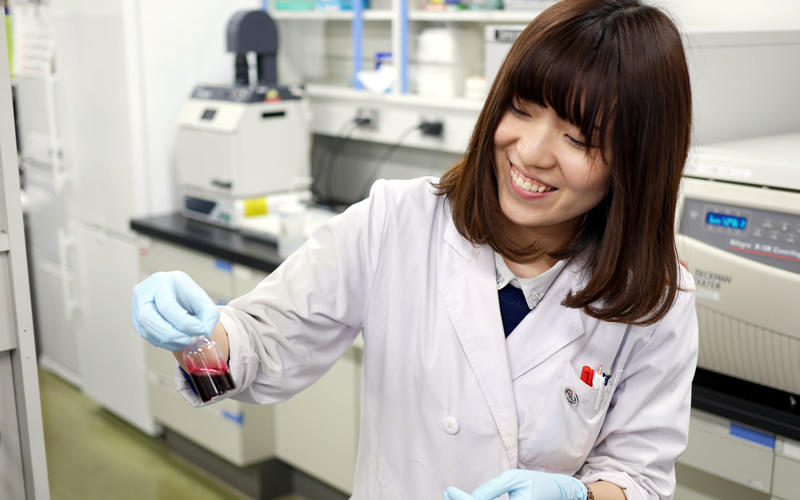
Kyoko Yokomaku, first year graduate student, smiles with the completed artificial blood product in her hand.
Sounds an ideal example of what a scientist should be! Unlike you, more young people are struggling to find what they really want to do.
When I ask students about their future, they often say they don't know what to do or will decide when they start looking for a job. In my first year chemistry class, I tell them to make a career plan as early as possible. They are forced to do so in three years, the final year of the undergraduate course. In getting a job or taking a graduate course, whatever the choice may be, there is no guarantee that you will make it. I understand this situation, but they might take it too serious. Nothing happens with that sort of attitude. Your goal can change. When you were much younger, you must have said you wanted to be a baseball player one day and an astronaut the next day without hesitation. On another day you might want to change jobs. That's fine. However, you need a goal in order to make things work out and feel motivated. At the same time, by setting a target you can decide what to work on.
Nowadays, many type of jobs are available along with a lot of related information. It must be difficult to make such a decision. I really feel for them.
Absolutely, there is no easy solution but I hope that more people will want to become scientists.
It's been a great pleasure talking to you.
Post-interview message
Being positive and shining throughout the interview, professor Komatsu was absolutely impressive. Sticking to what he loves, he became a leading scientist. I hope that his way of life touches not only students who are seeking careers but also those who already have one.
I also spoke with the students working in his lab. They all said such things as "professor Komatsu is very enthusiastic" and "he is so helpful and supportive for us." Thus, they are enjoying their research and working with him.
Wish all the best for his research!
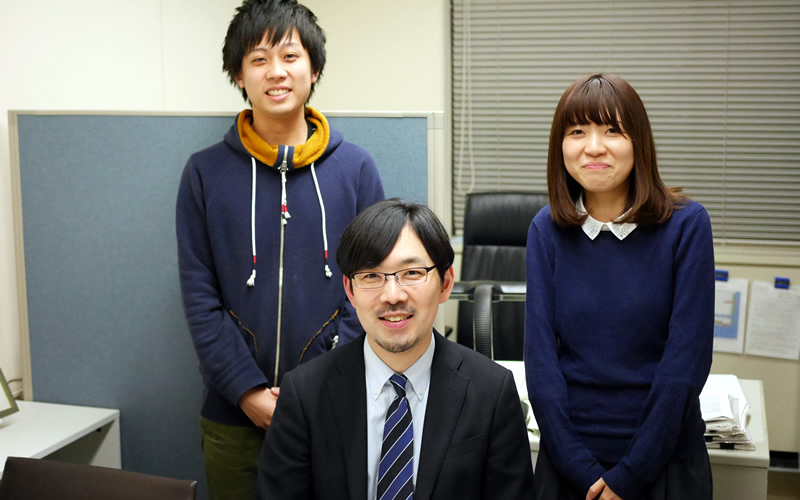
The development of an artificial oxygen carrier as a blood substitute is one of the top items on the agenda of next-generation healthcare. Japan has the world's high standard in terms of blood donation and transfusion service. However, Japan's ongoing low birth rate affects the number of people who can donate blood. Blood shortages are expected for 890,000 people a year, starting in 2027. Donated blood cannot be stored for more than three weeks. Blood shortages are also expected in case of such catastrophic events as a major earthquake. Consequently, there is high demand for an artificial oxygen carrier as a blood substitute. The research group lead by professor Komatsu of Chuo University has developed a hemoglobin-albumin cluster, which is a novel artificial oxygen carrier. The two major blood componentsーhemoglobin and albuminーare chemically connected in the cluster. Studies using animals have shown the cluster to be safe with no adverse effects, and that it can work as an oxygen carrier like a red blood cell in living animals. Since 2013, professor Komatsu has participated in space experiments to obtain information on safety and effectiveness, in order to establish the formulation for clinical use.
Hemoglobin-albumin cluster, a novel artificial oxygen carrier, has been developed.
In the cluster, albumin molecules are linked to the surface of a hemoglobin mokecule.

Hemoglobin-albumin cluster synthesis. Hemoglobin extracted from red blood cells is coated with albumin from blood serum.
Recognized as a blood serum protein by living organisms, the cluster is safe with high blood compatibility.